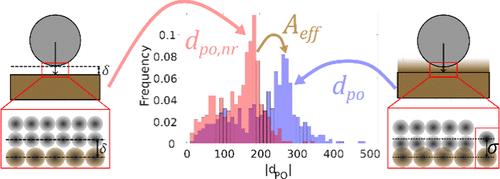短程分子间斥力对使用原子力显微镜估算哈马克常数的影响
IF 3.7
2区 化学
Q2 CHEMISTRY, MULTIDISCIPLINARY
引用次数: 0
摘要
原子力显微镜 (AFM) 能够表征表面形貌并确定 AFM 悬臂针尖-表面力,因此在估算给定固体材料的 Hamaker 常数 A 值方面非常有效。在接近接触法(AtC)中,Hamaker 常数是根据原子力显微镜针尖首次与基底接触时的偏转推断出来的。在拉离 (PO) 方法中,原子力显微镜针尖最终被拉离基底时产生的偏转被用来估算 A 值。在对这些短程陡峭斥力进行物理相关描述后,我们研究了斥力相互作用对现有 AtC 和 PO 方法在低湿度或真空条件下应用于中性带电系统时估算出的 A 值的影响。对于与实验相关的表面,我们发现斥力对 AtC 方法的影响不大,但仍需考虑斥力的影响,以改进哈梅克常数的估计值。另一方面,斥力对 PO 方法推断出的 Hamaker 常数有很大影响,在使用这种方法时必须适当考虑。我们的分析还包括将表面粗糙度明确纳入 PO 方法,这在之前的大多数 PO 方法应用中并不常见。本文章由计算机程序翻译,如有差异,请以英文原文为准。

The Effects of Short-Range Intermolecular Repulsive Forces on Hamaker Constant Estimation Using Atomic Force Microscopy
The atomic force microscope (AFM), as it is able to characterize surface topography as well determine the AFM cantilever tip–surface force, proves effective at estimating the value of the Hamaker constant, A, for a given solid material. Two main AFM-based methods have been proposed for estimating values of A. In the approach-to-contact (AtC) method, Hamaker constants are inferred from the deflections at which the AFM tip first jumps into contact with the substrate. In the pull-off (PO) method, the deflections that arise when the AFM tip is finally pulled away from the substrate are used to estimate values of A. In prior applications of these two methods, the short-range intermolecular repulsive forces that are known to arise between the AFM tip and the substrate were, however, ignored. Upon invoking a physically relevant description of these short-range and steeply repulsive forces, we investigate the effects of repulsive interactions on the values of A estimated from the existing AtC and PO methods when applied to neutrally charged systems under low humidity or vacuum conditions. For experimentally relevant surfaces, we find that repulsive forces have a modest effect on the AtC method, although they still need to be accounted for in order to generate improved estimates of the Hamaker constant. On the other hand, repulsive forces have a significant effect on the Hamaker constants inferred from the PO method, and must be properly accounted for when using this approach. Our analysis also includes an explicit incorporation of surface roughness into the PO method, which is not typically done in most prior applications of the PO method.
求助全文
通过发布文献求助,成功后即可免费获取论文全文。
去求助
来源期刊

Langmuir
化学-材料科学:综合
CiteScore
6.50
自引率
10.30%
发文量
1464
审稿时长
2.1 months
期刊介绍:
Langmuir is an interdisciplinary journal publishing articles in the following subject categories:
Colloids: surfactants and self-assembly, dispersions, emulsions, foams
Interfaces: adsorption, reactions, films, forces
Biological Interfaces: biocolloids, biomolecular and biomimetic materials
Materials: nano- and mesostructured materials, polymers, gels, liquid crystals
Electrochemistry: interfacial charge transfer, charge transport, electrocatalysis, electrokinetic phenomena, bioelectrochemistry
Devices and Applications: sensors, fluidics, patterning, catalysis, photonic crystals
However, when high-impact, original work is submitted that does not fit within the above categories, decisions to accept or decline such papers will be based on one criteria: What Would Irving Do?
Langmuir ranks #2 in citations out of 136 journals in the category of Physical Chemistry with 113,157 total citations. The journal received an Impact Factor of 4.384*.
This journal is also indexed in the categories of Materials Science (ranked #1) and Multidisciplinary Chemistry (ranked #5).
 求助内容:
求助内容: 应助结果提醒方式:
应助结果提醒方式:


